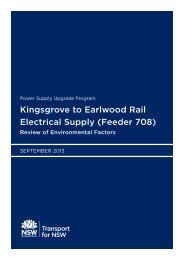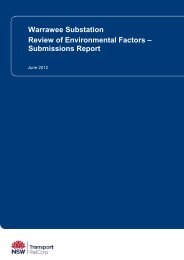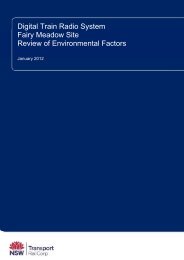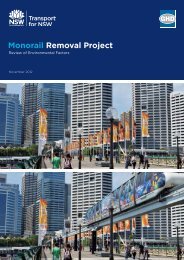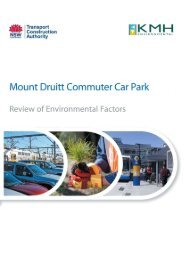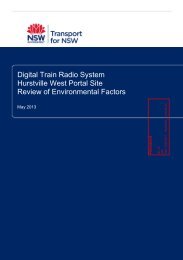Warrawee Substation - Review of Environmental Factors
Warrawee Substation - Review of Environmental Factors
Warrawee Substation - Review of Environmental Factors
- No tags were found...
You also want an ePaper? Increase the reach of your titles
YUMPU automatically turns print PDFs into web optimized ePapers that Google loves.
<strong>Warrawee</strong> <strong>Substation</strong> Page 13Operational Noise & Construction Noise & Vibration AssessmentReport No. 11332 Version BAttended measurements indicated that the primary noise sources are:Rectifier enclosed in substation (and 1 standby rectifier);One transformer is audible with up to 3dB increase in noise levels during train pass(and 1 auxiliary transformer); andDirect Current Circuit breaker (DCCB).DCCB tripping is extremely rare. This would typically be absent during normal operation <strong>of</strong> thesubstation as it is only a fault condition. It is more likely to occur when the substation is underload when trains are running, but could occur in the middle <strong>of</strong> the night.Attended measurements were not obtained for the DCCB. DCCB tripping is an extremelyinfrequent event with approximately 3 openings within a substation per year (if the openingswere uniformly spread across all DCCB’s per year). Previous operational noise assessment forYagoona Traction <strong>Substation</strong> stated that the internal sound pressure level <strong>of</strong> the DCCB trippingis L Amax 113dBA.Based on the extremely infrequent DCCB openings, this event has not been included for thetypical operational assessment. However, it is necessary to predict the likely noise levels.As there are openings for ventilation along the eastern façade <strong>of</strong> the building, the predictednoise level at the receivers when this occurs is likely to be approximately 60dBA, which wouldbe clearly audible at the closest residences. This level could be reduced by acoustically treatingthe openings which face the closest residences (acoustic louvres or internally lined ducts).Observations made during the attended measurements indicated that rectifier and transformernoise levels fluctuates during train passes, therefore worst-case noise levels have been used forassessment purposes even though it is unlikely that the transformers will be under load duringthe quietest part <strong>of</strong> the night time period.Further observations as noted in Table 4-1 indicate that the rectifier is inaudible outside thesubstation building. The active transformer is audible with up to 3dB fluctuations in noise levelsbefore, during and after train passes with levels dropping shortly after.Additionally, no tonal characteristics were observed from the third octave band analysis <strong>of</strong>transformer measurements. A third octave band spectrum has been included in Appendix B.5.2 Predicted Noise Levels at ReceiversOperational noise levels have been predicted to the closest receivers. Table 4-2 provides asummary <strong>of</strong> predicted noise levels for the night time period where background noise levels areat the lowest. In predicting noise levels it has been assumed that the rectifiers and bothprimary transformers would be running under load. A conservative 5dB attenuation has beenassumed for the shielding provided by the solid brick wall on the eastern facade, and theretaining wall and rail corridor on the western facade. Predictions were made using geometricspreading and an allowance for shielding.



